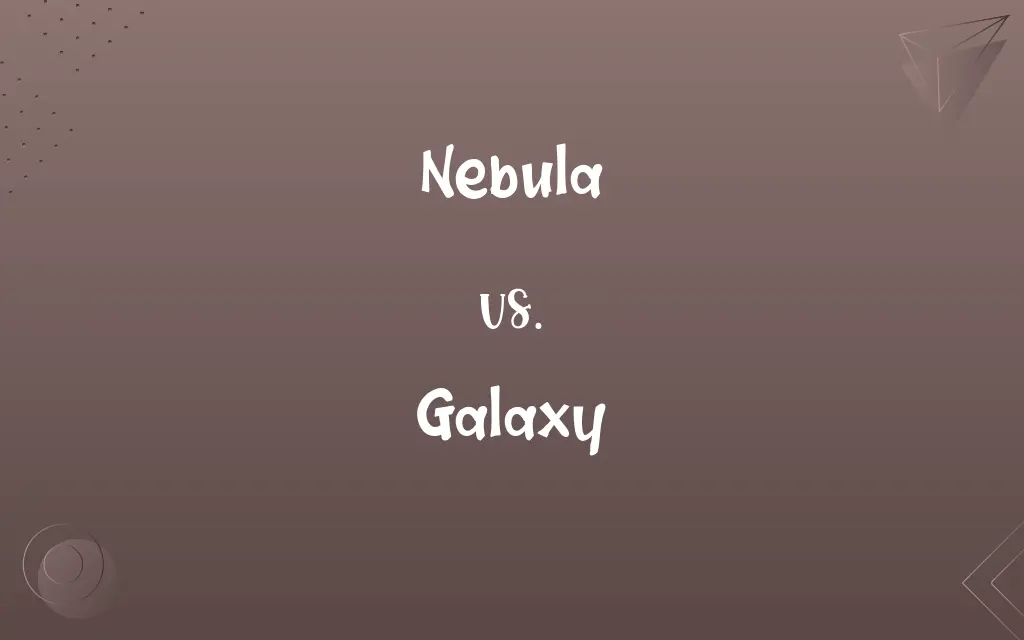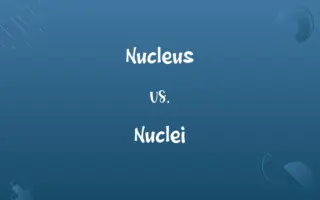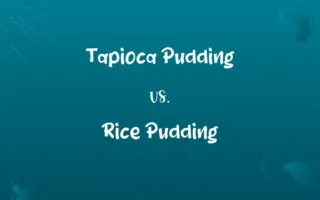Nebula vs. Galaxy: Know the Difference

By Shumaila Saeed || Published on January 11, 2024
Nebula is an interstellar cloud of dust, hydrogen, helium, and other ionized gases. Galaxy is a massive, gravitationally bound system consisting of stars, stellar remnants, interstellar gas, dust, and dark matter.

Key Differences
A nebula is a vast cloud of gas and dust in space, often serving as a nursery for new stars. In contrast, a galaxy is a much larger assembly of billions of stars, along with gas, dust, and dark matter, bound together by gravity.
Shumaila Saeed
Jan 11, 2024
While nebulae are components within galaxies, known for their beautiful colors and structures, galaxies themselves are the overarching structures that organize much of the visible universe.
Shumaila Saeed
Jan 11, 2024
The size of a nebula can vary, but it is significantly smaller than a galaxy, which can span thousands to hundreds of thousands of light-years across.
Shumaila Saeed
Jan 11, 2024
Nebulae often mark the regions where star formation is actively taking place, whereas galaxies encompass a wider variety of astronomical phenomena, including black holes, star clusters, and nebulae.
Shumaila Saeed
Jan 11, 2024
In terms of composition, a nebula primarily contains hydrogen and helium gas, while a galaxy includes not only these gases but also stars, planets, and other celestial bodies.
Shumaila Saeed
Jan 11, 2024
ADVERTISEMENT
Comparison Chart
Structure
Often amorphous or filamentous
Diverse, including spiral, elliptical
Shumaila Saeed
Jan 11, 2024
Visibility
Visible with telescopes, often colorful
Visible with naked eye (some galaxies)
Shumaila Saeed
Jan 11, 2024
ADVERTISEMENT
Nebula and Galaxy Definitions
Nebula
A cloud of gas and dust in space.
The Orion Nebula is one of the brightest nebulae visible to the naked eye.
Shumaila Saeed
Dec 18, 2023
Galaxy
A large system of stars, planets, and other celestial bodies bound by gravity.
The Milky Way is the galaxy that contains our solar system.
Shumaila Saeed
Dec 18, 2023
Nebula
An interstellar region of ionized gases.
The Hubble Space Telescope captured stunning images of the Horsehead Nebula.
Shumaila Saeed
Dec 18, 2023
Galaxy
A cosmic structure with a distinct shape, such as spiral or elliptical.
The Whirlpool Galaxy is known for its classic spiral shape.
Shumaila Saeed
Dec 18, 2023
Nebula
A remnant of a supernova explosion.
The Crab Nebula is the result of a supernova observed in 1054.
Shumaila Saeed
Dec 18, 2023
ADVERTISEMENT
Galaxy
An assembly of stars, dust, and dark matter.
The Andromeda Galaxy is on a collision course with the Milky Way.
Shumaila Saeed
Dec 18, 2023
Nebula
A diffuse astronomical object observable in the night sky.
Through my telescope, I glimpsed the Lagoon Nebula last night.
Shumaila Saeed
Dec 18, 2023
Galaxy
Any of numerous large-scale aggregates of stars, gas, and dust that constitute the universe, containing an average of 100 billion (1011) solar masses and ranging in diameter from 1,500 to 300,000 light-years.
Shumaila Saeed
Dec 13, 2023
Nebula
A diffuse cloud of interstellar dust or gas or both, visible as luminous patches or areas of darkness depending on the way the mass absorbs or reflects incident light or emits its own light.
Shumaila Saeed
Dec 13, 2023
Galaxy
An assembly of brilliant, glamorous, or distinguished persons or things
A galaxy of theatrical performers.
Shumaila Saeed
Dec 13, 2023
Galaxy
The Milky Way; the apparent band of concentrated stars which appears in the night sky over earth.
Shumaila Saeed
Dec 13, 2023
Galaxy
(galaxy) Any of the collections of many millions or billions of stars, galactic dust, black holes, etc. existing as independent and coherent systems, of which there are billions in the known universe.
Shumaila Saeed
Dec 13, 2023
Nebula
(astronomy) A cloud in outer space consisting of gas or dust (e.g. a cloud formed after a star explodes).
Shumaila Saeed
Dec 13, 2023
Galaxy
(figuratively) An assemblage of things or people seen as luminous or brilliant.
Shumaila Saeed
Dec 13, 2023
Galaxy
Any print or pattern reminiscent of a galaxy, generally consisting of blending, semiopaque patches of vibrant color on a dark background.
Shumaila Saeed
Dec 13, 2023
Nebula
A faint, cloudlike, self-luminous mass of matter situated beyond the solar system among the stars. The term was originally applied to any diffuse luminous region. Now, technically, it is applied to interstellar clouds of dust and gases (diffuse nebula). However distant galaxies and very distant star clusters often appear like them in the telescope, such as the spiral nebula in Andromeda, known now to be a distant galaxy.
Shumaila Saeed
Dec 13, 2023
Galaxy
The Milky Way, that luminous tract, or belt, which is seen at night stretching across the heavens, and which is composed of innumerable stars, so distant and blended as to be distinguishable only with the telescope.
Shumaila Saeed
Dec 13, 2023
Galaxy
A very large collection of stars comparable in size to the Milky Way system, held together by gravitational force and separated from other such star systems by large distances of mostly empty space. Galaxies vary widely in shape and size, the most common nearby galaxies being over 70,000 light years in diameter and separated from each other by even larger distances. The number of stars in one galaxy varies, and may extend into the hundreds of billions.
Shumaila Saeed
Dec 13, 2023
Galaxy
A splendid or impressive assemblage of persons or things; as, a galaxy of movie stars.
Shumaila Saeed
Dec 13, 2023
Nebula
An immense cloud of gas (mainly hydrogen) and dust in interstellar space
Shumaila Saeed
Dec 13, 2023
Galaxy
Tufted evergreen perennial herb having spikes of tiny white flowers and glossy green round to heart-shaped leaves that become coppery to maroon or purplish in fall
Shumaila Saeed
Dec 13, 2023
Nebula
A region in space where new stars are born.
Astronomers study the Eagle Nebula to understand star formation.
Shumaila Saeed
Dec 18, 2023
Galaxy
(astronomy) a collection of star systems; any of the billions of systems each having many stars and nebulae and dust;
`extragalactic nebula' is a former name for `galaxy'
Shumaila Saeed
Dec 13, 2023
Galaxy
A vast collection of star systems and interstellar space.
Scientists estimate there are billions of galaxies in the observable universe.
Shumaila Saeed
Dec 18, 2023
Galaxy
A gravitationally bound system visible as a distinct patch in the night sky.
Last night, I was able to spot the Triangulum Galaxy with my telescope.
Shumaila Saeed
Dec 18, 2023
Repeatedly Asked Queries
What is a Galaxy?
A galaxy is a massive system of stars, interstellar gas, and dust, all held together by gravity.
Shumaila Saeed
Jan 11, 2024
How big are Galaxies?
Galaxies range in size from a few thousand to hundreds of thousands of light-years in diameter.
Shumaila Saeed
Jan 11, 2024
How big are Nebulae?
Nebulae vary in size but are much smaller than galaxies, typically spanning a few light-years across.
Shumaila Saeed
Jan 11, 2024
Are all galaxies composed of stars?
Galaxies contain stars, but they also consist of other components like gas, dust, and dark matter.
Shumaila Saeed
Jan 11, 2024
Are galaxies constantly in motion?
Yes, galaxies are in motion due to the gravitational forces among their components and interactions with neighboring galaxies.
Shumaila Saeed
Jan 11, 2024
What is a Nebula?
A nebula is a cloud of gas and dust in space, often where new stars form.
Shumaila Saeed
Jan 11, 2024
What is a spiral galaxy?
Spiral galaxies have a spiral arm structure and often contain both young and old stars.
Shumaila Saeed
Jan 11, 2024
Are Nebulae part of Galaxies?
Yes, nebulae are often found within galaxies.
Shumaila Saeed
Jan 11, 2024
Can nebulae be seen with the naked eye from Earth?
Some nebulae, like the Orion Nebula, are visible to the naked eye, while others require telescopes to be observed.
Shumaila Saeed
Jan 11, 2024
Do nebulae have a specific shape or structure?
Nebulae come in various shapes, including irregular, spherical, and filamentary, depending on their formation and surrounding conditions.
Shumaila Saeed
Jan 11, 2024
Are nebulae related to star formation?
Yes, many nebulae are regions where new stars are formed, known as stellar nurseries.
Shumaila Saeed
Jan 11, 2024
Can we see Galaxies with the naked eye?
Some galaxies, like the Andromeda Galaxy, are visible to the naked eye in dark skies.
Shumaila Saeed
Jan 11, 2024
Can galaxies collide with each other?
Yes, galaxies can collide and merge, leading to the formation of new galaxies and the redistribution of stars.
Shumaila Saeed
Jan 11, 2024
What is an elliptical galaxy?
Elliptical galaxies are characterized by their oval or spherical shape and contain mainly older stars.
Shumaila Saeed
Jan 11, 2024
What is the most famous nebula visible from Earth?
The Orion Nebula (M42) is one of the most famous and easily observable nebulae from Earth.
Shumaila Saeed
Jan 11, 2024
Can planets be found within nebulae?
Planets are typically not found within nebulae; they are more commonly associated with stars.
Shumaila Saeed
Jan 11, 2024
Do galaxies have supermassive black holes at their centers?
Many galaxies are believed to have supermassive black holes at their centers, including the Milky Way.
Shumaila Saeed
Jan 11, 2024
Do nebulae emit their own light?
Nebulae often appear to emit light, but they do so by reflecting or being illuminated by nearby stars.
Shumaila Saeed
Jan 11, 2024
Are nebulae only found in our galaxy?
Nebulae can be found both within and outside our Milky Way galaxy.
Shumaila Saeed
Jan 11, 2024
Share this page
Link for your blog / website
HTML
Link to share via messenger
About Author
Written by
Shumaila SaeedShumaila Saeed, an expert content creator with 6 years of experience, specializes in distilling complex topics into easily digestible comparisons, shining a light on the nuances that both inform and educate readers with clarity and accuracy.





































































